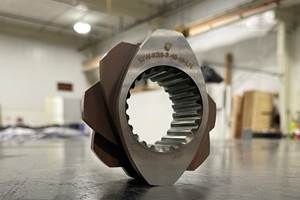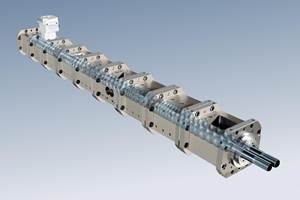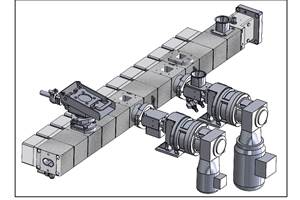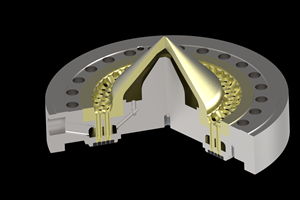A Pioneer in ‘Clean Compounding’
When Plastics Color Corp., based in Calumet City, Ill., established a new compounding plant in Southern California, the firm decided this couldn’t be an ordinary color/additive masterbatch facility.
When Plastics Color Corp., based in Calumet City, Ill., established a new compounding plant in Southern California, the firm decided this couldn’t be an ordinary color/additive masterbatch facility. The new PCC plant in Sun Valley opened in January and is aimed at a regional clientele consisting largely of makers of food and pharmaceutical packaging and medical devices. Such customers ensure high levels of cleanliness and purity in their own products, so it made sense that they would want the same care to be taken in producing masterbatches that go into their products.
As there are no standards yet for “clean compounding,” PCC had to chart its own course, helped by suggestions from customers. Sun Valley was to be PCC’s first top-to-bottom “clean” facility, but it could draw on its experience in establishing a “plant-within-a-plant” clean operating area at its plant in Asheboro, N.C., in 2009. A team from Asheboro was brought to Sun Valley, led by project engineering manager Alan Abrams, who designed the new plant.
The 30,000-ft² plant currently has two Coperion twin-screw compounding lines capable of 1 million lb/yr, though there’s room to quadruple that capacity. Only FDA-approved additives are used here, and no black products (they’re made in Calumet City).
The emphasis on cleanliness at Sun Valley starts with white walls and ceiling, plus 24 skylights that illuminate the plant with nearly twice the brightness of a standard manufacturing facility. Dirt has no place to hide.
The manufacturing area is kept at a positive air pressure, with airlock doors. Employees wear shoe protection and clothing with no cuffs or folds to catch pellets or dirt, and no jewelry. No wood pallets or cardboard are allowed in the production area.
Two of the main technical features of this “clean” plant are filtration for air and process water. All water from the pelletizing lines passes through a 5-micron filter and is exposed to UV light to kill microbes. Plant air is filtered through a water curtain, an evaporative cooling system in which a film of water flows by gravity over a fine mesh. Passing through this curtain, air is cooled and particulates are removed. After startup, the lines run completely automatically. “Hands never touch the material before it is sealed in the bag,” says Joe Byrne, vp of sales and marketing.
An important factor in minimizing raw-materials handling for both cleanliness and efficiency is the use of a Mixaco batch-mixing system. “We used to move materials through the plant in several steps and by hand. Now we weigh, mix, and transport material in the same vessel,” says Byrne. “It’s a single point of contact for raw materials,” adds Abrams. After mixing, the vessel is disengaged from the mixer, covered, and wheeled over to the extrusion line, where it is hoisted up onto a mezzanine atop a gravimetric feeder.
Among other benefits, the mixing bowls can be cleaned easily and comfortably in just 11 min, vs. 45 min for previous mixing systems. “We’re getting that time down even further,” notes Abrams. (Mixaco USA is in Greer, SC; .)
“There’s definitely a ‘Wow’ factor when customers visit this plant,” says Tim Workman, director of ´óÏó´«Ã½ development. “They’ve never seen a compounding plant that looks like this.” He adds that though Sun Valley is not yet a true clean-room facility, “We’re ready to go to the next step when the market demands it.”
Related Content
How to Configure Your Twin-Screw Extruder: Part 3
The melting mechanism in a twin-screw extruder is quite different from that of a single screw. Design of the melting section affects how the material is melted, as well as melt temperature and quality.
Read MoreHow to Configure Your Twin-Screw Barrel Layout
In twin-screw compounding, most engineers recognize the benefits of being able to configure screw elements. Here’s what you need to know about sequencing barrel sections.
Read MoreStrategically Manage Pressure to Help Ensure Quality in Co-Rotating Twin-Screw Extrusion
Pressure measurement provides an invaluable window into any extrusion process, but it must also be strategically managed at every stage of the process to ensure a quality part is being extruded.
Read MoreHow to Maintain Pelletizing Quality When Acid Attacks
Developments in the chemistry of polymers and additives have made corrosion a real problem in pelletizers. Here’s how to ward it off.
Read MoreRead Next
Beyond Prototypes: 8 Ways the Plastics Industry Is Using 3D Printing
Plastics processors are finding applications for 3D printing around the plant and across the supply chain. Here are 8 examples to look for at NPE2024.
Read MoreSee Recyclers Close the Loop on Trade Show Production Scrap at NPE2024
A collaboration between show organizer PLASTICS, recycler CPR and size reduction experts WEIMA and Conair recovered and recycled all production scrap at NPE2024.
Read More











